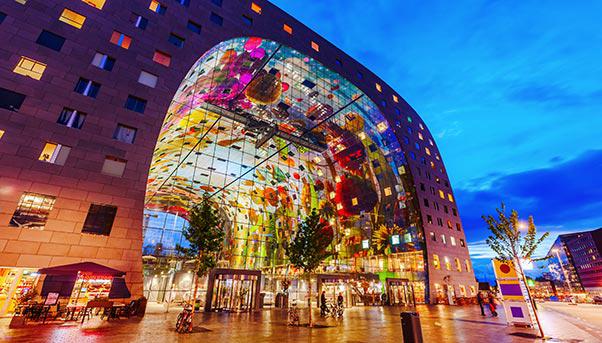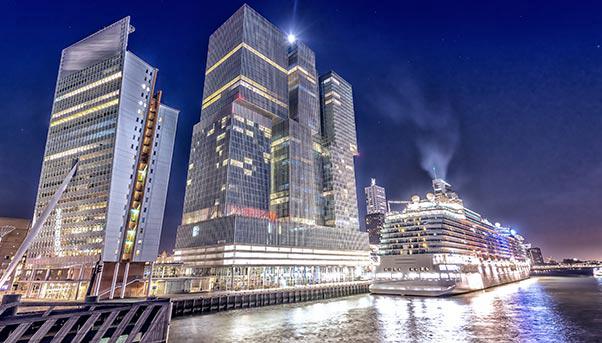
As the Spido tour boat follows the main canal out to the North Sea, the tourists aboard get a full view of Rotterdam. On one side of the Dutch port city are the containers, resting in orderly rows along the edge of their facility. On the other side is the urban skyline with its bridges and skyscrapers. But the view admired from the boat is not static, for Rotterdam has been in perpetual development since the end of the Second World War. In this busy port city, where income per capital is among the highest in Europe, infrastructure does not simply accompany the skyline but actually contributes to it.
Rotterdam was the first place in Europe to have a skyscraper. Built in 1898, the Witte Huis, a 10-floor Art Nouveau building that stands 43 metres tall, was the first to leave a modern imprint on the port city, which would undergo a number of transformations during the following century.
Beginning of the renewal
Rotterdam is the result of a major reconstruction of the port city’s infrastructure after it was obliterated in the Second World War. An architectural boom began in the 1950s, marked by a grandiose plan to rebuild the port city. One example is the Lijnbaan, the first modern shopping street in post-war Europe where cars were prohibited.
This urban commitment continues to this day. Rotterdam has an efficient public transport system, with bicycle lanes, trams, metro lines and water taxis to ease movement throughout the port city. Investments have reached every sector: the central station has been fitted to serve high-speed trains, while the A15 highway was extended by 47 kilometres for €1.5 billion.
The challenge of urban planning is shifting towards sustainable development. A lot of investment has been made in projects to reduce the CO2 emissions, such as a less polluting transport system. In 2015, the port city launched the “Rotterdam Sustainability Programme”, a four-year investment plan for €400 million for sustainable projects. The port itself has “Port Vision 2030”, which foresees a series of investments dedicated to improving the sustainability of its facilities. Such initiatives have helped Rotterdam get ranked among what the Rockefeller Foundation terms the 100 Resilient Cities that keep innovating to improve the lives of its residents.

The port
Rotterdam’s biggest infrastructure and logistical hub is obviously the port. The biggest in Europe and one of the biggest in the world, it is a city within a city, covering 120 square kilometres, employing 90,000 people and receiving 119,000 ships every year.
It is a story of investment and growth by stages, the last of which began in 2014 when the Port of Rotterdam Authority started taking back from the sea 2,000 hectares of land to expand the port’s entrance by 20% and make it accessible for the industry’s biggest cargo ships that stretch 400 metres and carry 18,000 containers. The Authority – an entity one third owned by the state and two thirds by the port city – has invested €2 billion, while APM Terminals of Denmark’s Maersk Group and Rotterdam World Gateway have each invested €1 billion each in exchange for the right to manage the area. The goal is to increase the amount of TEUs (Twenty-Foot Equivalent Units of cargo) handled by the port every year by 30 million by 2035. At the moment, the port handles 461 million TEUs.
In 2016, the Authority launched another project: the €275 million construction of a bridge that will enable the railway that links the port with Germany to pass over the canal without interfering with vehicle traffic.
The railway to germany
Rotterdam’s strength as a port is its connection to the heart of continental Europe, allowing for the quick transfer of cargo virtually anywhere. Its most important link is the Betuweroute, a railway line that quickly brings cargo 159 kilometres to Emmerich, Germany. Inaugurated in 2007 by Queen Beatrix, the €4.7 billion line belongs to the Trans-European Network (TEN) of strategic railways. A project of the European Commission, the TEN called for the construction of 18 kilometres of tunnels, 130 bridges and 12 kilometres of viaducts to bring it closer to completion.
Bridge and skyscrapers
Civic buildings have joined the port city’s infrastructure in shaping the skyline. In recent years, it has done so in a profound way. Along the canals through which pass the Spido tour boat famous architects like Rem Koolhaas, Renzo Piano and Alvaro Siza have designed impressive buildings.
Rising above them all is the Euromast, a 185-metre-high tower at the top of which the view is clear for 80 kilometres – all the way to Antwerp.
The Erasmus Bridge, built in 1996 at a cost of €165 million, is another structure that has come to represent Rotterdam. More than 800 metres long with a tower 139 metres high, it is a crucial link between the north and south of the port city.

